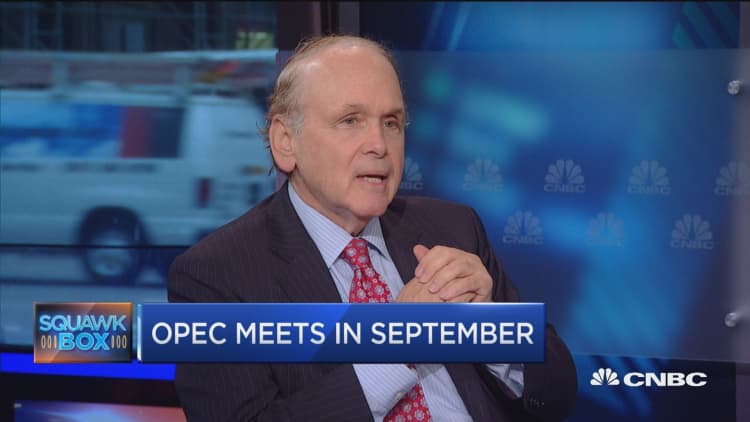
Oil prices hit one-month highs on Monday, gaining about 10.8 percent in a three-day rally as speculation intensified over potential producer action to support prices amid a crude glut.
Data from market intelligence firm Genscape estimating a draw of more than 350,000 barrels at the Cushing, Oklahoma delivery point for U.S. crude futures last week added to the bullish sentiment, said traders who saw the data.
Brent crude was up $1.37, or 2.92 percent, at $48.33 per barrel. Brent has gained about 10 percent cumulatively in the past three sessions, its most in such a stretch since May. Since the start of August, it is up about 13 percent.
U.S. West Texas Intermediate (WTI) crude rose $1.25, or 2.81 percent, to $45.74 a barrel, after rallying earlier to $45.75, a peak since July 18. WTI has gained about 10 percent on the month.

Members of the Organization of the Petroleum Exporting Countries are to meet on the sidelines of the International Energy Forum, which groups producers and consumers, in Algeria from Sept. 26-28.
Russian Energy Minister Alexander Novak bolstered hopes on Monday that oil producing nations could take action to stabilise prices, telling a Saudi newspaper that his country was consulting with Saudi Arabia and other producers to achieve market stability.
"With Russia joining the chorus, an array of bullish oil ETFs saw a sizeable influx of capital that lifted crude values by more than $5 a barrel off recent lows," said Jim Ritterbusch of Chicago-based oil markets consultancy Ritterbusch & Associates.
"While we see very little possibility of an actualization of curtailed OPEC output, there will likely be enough chatter during the next five to six weeks to deter selling in allowing WTI to gravitate at around the $45 area, at least through the second half of this month," he added.
But other analysts were sceptical that the rally would continue.
"In our view a renewed price correction cannot be ruled out if market participants start focusing on the supply side again, for the latest drilling activity figures in the U.S. cast doubts that the oversupply is really being eroded," Commerzbank analyst Carsten Fritsch said in a note.
Baker Hughes data released on Friday showed the number of rigs operating in the U.S. rose by 15 last week to 396.
While that is far below the 1,600 rigs that were in operation in 2014 before the price rout, the rig count has steadily risen from a low of just 316 in late May as U.S. producers adjusted to lower prices.

Doubts also abounded over the chances of OPEC putting aside a market share battle in order to prop up prices. Iran is edging out Russia in a fight to supply crude oil to Poland, while its crude exports to South Korea jumped nearly four fold in July from the previous year.
"The (OPEC) meeting is unlikely to yield anything because OPEC are caught in a squeeze," David Hufton of oil brokers PVM wrote on Monday. "On the supply side it is their own increase in production that is prolonging the price depression but if they freeze or restrain production to lift prices they will stimulate competing non-OPEC supply and lose market share."
On the demand side, the world's three biggest economies — the United States, China and Japan — all published downbeat economic data between Friday and Monday.
The countries are also among three of the world's five biggest crude consumers and traders said slower economic growth in those countries could start weighing on crude markets.

